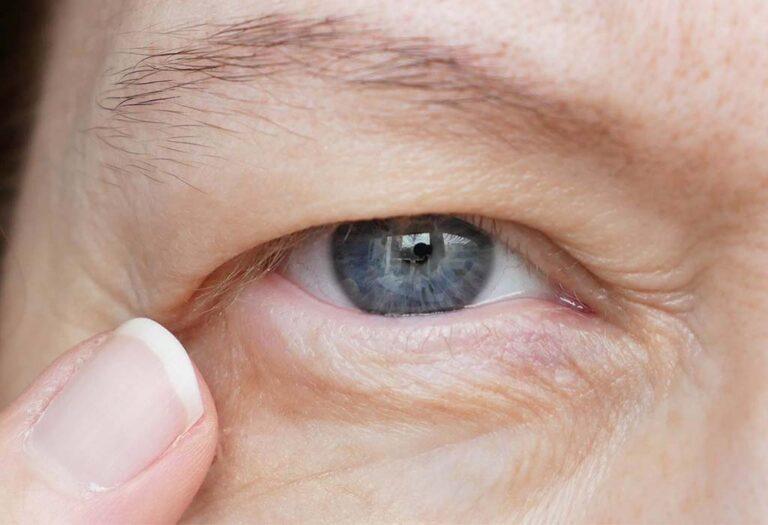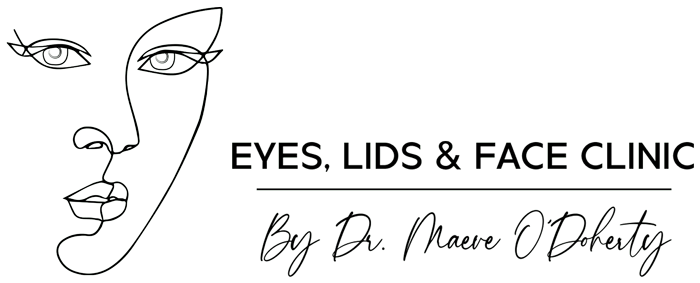
Droopy Eyelid Correction (Ptosis)
What is Ptosis
(Droopy Eyelids)

Ptosis, commonly referred to as droopy eyelids, is a condition characterised by the drooping or sagging of one or both upper eyelids. This drooping can vary in severity, ranging from a slight hooding of the upper eyelid to a significant obstruction of vision. Ptosis can affect individuals of all ages, from infants to the elderly, and may occur for various reasons.
Some people opt to undergo ptosis repair surgery to correct the droopy eyelids issue. If you are considering ptosis surgery, we will assess your medical history and your currently ocular health before making a recommendation. It is essentially the process of lifting the eyelids to improve vision. The surgery is highly specialised and our surgeon has specialised training in addition to medical school and a residency in eye surgery and ophthalmology.
Eyes, Lids & Face by Dr. Maeve
Symptoms of Ptosis

Ptosis — a condition where the upper eyelid droops — can affect one or both eyes, impacting both appearance and vision. It may develop gradually or suddenly, and recognizing the symptoms early can help guide the right treatment.
If you’re experiencing any of these symptoms, professional assessment can determine whether surgery or other treatments can restore both function and appearance.
Drooping or sagging
of one or both upper eyelids. The eyelid may partially cover the eye, obstructing vision.
Difficulty keeping the eyes open
You may feel like you’re constantly fighting to keep your eyes from closing.
Decreased peripheral vision
Sagging eyelids can block the upper part of your field of view.
Eyestrain or fatigue
from constantly lifting the eyelids. Your forehead muscles may work overtime to help lift your lids, leading to discomfort.
A tired or sleepy appearance
Even when well-rested, ptosis can give the face an exhausted look.
Uneven or asymmetrical eyelids
One eyelid may sit noticeably lower than the other, creating an imbalanced look.
Eyes, Lids & Face by Dr. Maeve
Causes of Ptosis
Ptosis can develop for a variety of reasons — from natural aging to underlying medical conditions. Understanding the cause is key to finding the right treatment. Here are the most common causes:
- Age-Related Changes
Over time, the muscles and tissues that support the eyelids can weaken, causing them to gradually droop. This natural aging process is one of the most common causes of ptosis. - Congenital Ptosis
Some people are born with ptosis due to improper development of the muscles responsible for lifting the eyelid. This can be noticeable at birth or become apparent later in childhood. - Neurological Conditions
Disorders that affect the nerves controlling eyelid movement — such as stroke, brain tumors, or myasthenia gravis — can lead to ptosis, often alongside other neurological symptoms. - Trauma or Injury
Blunt force trauma or surgical procedures around the eyes can damage the muscles or nerves involved in eyelid movement, resulting in drooping.
If you’re experiencing persistent eyelid drooping, identifying the cause is essential for effective treatment — whether that’s surgery, therapy, or managing an underlying condition.
Eyes, Lids & Face by Dr. Maeve
Treatment Options for Ptosis

The treatment for ptosis depends on its underlying cause and severity. In some cases, mild ptosis may not require intervention, especially if it does not interfere significantly with vision or aesthetics. However, if ptosis affects vision or causes discomfort, various treatment options may be considered:
Surgical Correction
Ptosis repair surgery involves tightening the muscles or tissues responsible for lifting the eyelids to improve their position and function. This procedure can often be performed on an outpatient basis and typically results in a significant improvement in eyelid position and symmetry.
Medication
In cases where ptosis is caused by underlying neurological conditions such as myasthenia gravis, treatment with medications or other therapeutic interventions may be recommended to manage the underlying condition and alleviate symptoms.
Cosmetic Procedures:
For individuals with mild ptosis who are primarily concerned with aesthetic appearance, cosmetic procedures such as Botox injections may be considered to temporarily elevate the eyelids and create a more youthful appearance.
Eyes, Lids & Face by Dr. Maeve
Ptosis FAQ's

Ptosis surgery, also known as eyelid ptosis repair or blepharoptosis surgery, is a surgical procedure designed to correct drooping or sagging of the upper eyelids, a condition known as ptosis. This surgery aims to improve the position and function of the eyelids, restoring a more youthful and symmetrical appearance while also addressing any functional impairments such as obstruction of vision.
- Drooping or sagging of one or both upper eyelids
- Difficulty keeping the eyes open
- Decreased peripheral vision
- Eyestrain or fatigue from constantly lifting the eyelids
- A tired or sleepy appearance
- Age-related Changes: As we age, the muscles and tissues that support the eyelids can weaken, leading to ptosis. This natural aging process can result in a gradual descent of the eyelids over time.
- Congenital Ptosis: Some individuals are born with ptosis due to abnormal development of the muscles responsible for lifting the eyelids. Congenital ptosis may be present at birth or become apparent shortly thereafter.
- Neurological Conditions: Ptosis can also be associated with neurological disorders or conditions that affect the nerves controlling the eyelid muscles. Neurological causes of ptosis may include stroke, brain tumor, or conditions like myasthenia gravis.
- Trauma or Injury: Injuries to the eye area, such as blunt force trauma or surgical procedures, can damage the muscles or nerves responsible for eyelid movement, resulting in ptosis.
- Swelling and Bruising: Swelling and bruising around the eyes are common after ptosis surgery. This usually resolves within a few days to a week but can persist for longer in some cases.
- Discomfort or Pain: Mild discomfort or pain around the surgical site is normal and can typically be managed with over-the-counter pain medications prescribed by your surgeon.
- Dry Eyes: Some patients may experience temporary dryness or irritation of the eyes following ptosis surgery. This can usually be alleviated with the use of lubricating eye drops or ointments.
- Infection: Although rare, there is a risk of infection at the surgical site. It’s essential to follow your surgeon’s post-operative care instructions carefully to minimize this risk.
- Scarring: While efforts are made to minimize scarring, some degree of scarring may occur at the incision site. In most cases, scars fade over time and become less noticeable.
- Asymmetry: Achieving perfect symmetry between the eyelids can be challenging, and in some cases, there may be slight asymmetry after ptosis surgery. However, skilled surgeons strive to achieve the best possible symmetry and aesthetic outcome.
- Overcorrection or Undercorrection: In some cases, the eyelids may be overcorrected or undercorrected, resulting in either too much or too little lift. Revision surgery may be necessary to address these issues if they occur.
- Changes in Eyelid Shape or Function: In rare cases, ptosis surgery may lead to changes in eyelid shape or function, such as difficulty closing the eyes completely or eyelid lag (the upper eyelid not following the eye down when looking down). These issues may require further evaluation and treatment by an experienced oculoplastic surgeon.
